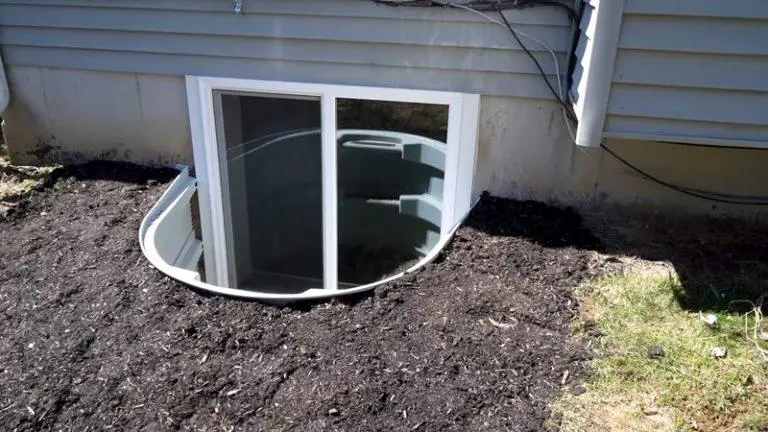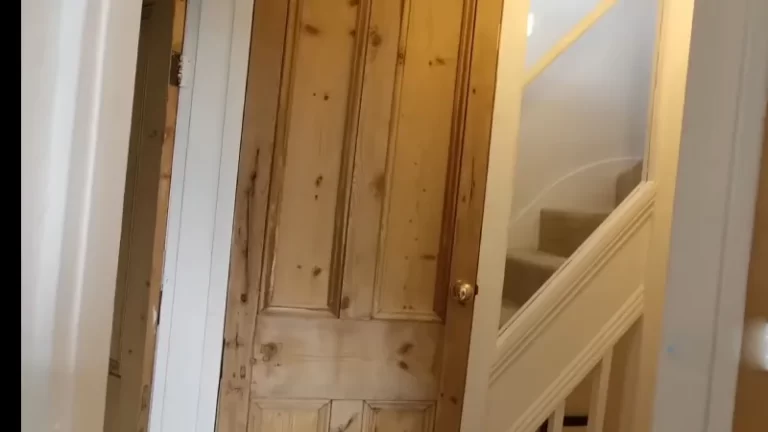Mortise Lock Won’t Open? Why? Fix?
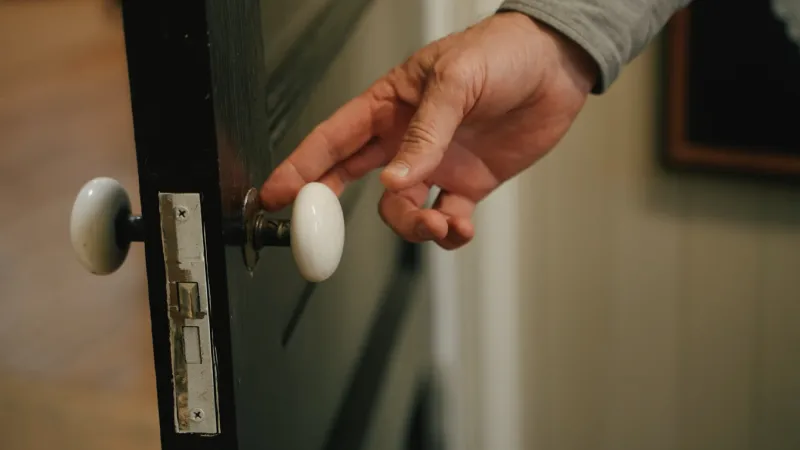
A mortise lock is a type of lock that is installed into a pocket or mortise in the door. It consists of a lock body that is installed into the door and a lock trim, such as a knob or lever, that is mounted on the exterior or interior side of the door.
The lock body contains a latch or bolt that is extended and retracted by the lock trim when the door is opened and closed.
One common problem with a mortise lock is when the latch becomes broken or stuck, preventing the door from opening. This can happen for a variety of reasons, such as wear and tear on the lock over time, misalignment of the lock components, or damage to the latch.
When the latch is stuck or broken, it will not retract when the lock trim is turned, and the door will remain locked. This can be frustrating and inconvenient, especially if you are unable to access the hinges to remove the door from the frame.
You'll Learn About
Why Won’t the Mortise Lock Open?
The interior part of your mortise lock, also known as the latch or bolt, is broken and not retracting when you turn the knob. This is preventing the door from opening. Some options you can try to open the door include:
- Using a penetrating oil like WD-40 on the latch to loosen any stuck parts and try turning the knob again.
- Using a screwdriver or other flat tool to try to push the latch back while turning the knob.
- If the door hinges are not visible, you may be able to use a pry bar or similar tool to spread the door from the frame and try to open it that way.
If none of these methods work, it may be necessary to remove the lock from the door for repair. This may require removing some door trim or using a drill to remove the screws holding the lock in place. Once the lock is removed, you should be able to access the broken latch and repair or replace it. It is recommended to hire a professional locksmith for this task as it can be complex and potentially damaging to the door if not done correctly.
Causes of a Mortise Lock Not Opening
A mortise lock, not opening can be caused by a broken or stuck latch, misalignment of the lock components, or wear and tear on the lock over time. It is important to identify the root cause of the problem in order to determine the best solution.
Broken or Stuck Latch
A broken latch is one of the most common causes of a mortise lock, not opening. The latch is the interior part of the lock that extends and retracts when the lock trim is turned. It is typically made of metal and can break or become stuck due to wear and tear misalignment of the lock components, or damage from forced entry.
Solution:
If the latch is broken, it will not be able to retract when the lock trim is turned, and the door will not open. If the latch is stuck, it may be difficult or impossible to retract it even if the lock trim is turned.
Misalignment of Lock Components
Another possible cause of a mortise lock, not opening is a misalignment of the lock components. This can happen if the lock body is not properly installed in the door or if the lock trim is not properly aligned with the lock body. When the components are misaligned, the latch may not be able to fully extend or retract when the lock trim is turned, causing the door to remain locked.
Wear and Tear on the Lock Over Time
Over time, a mortise lock can become worn and damaged due to regular use. This can cause the latch to become stuck or the lock components to become misaligned, leading to difficulty opening the door.
In addition, the lock may not function properly if the internal mechanisms are worn or damaged. Wear and tear can also make the lock more vulnerable to being forced open by an intruder.
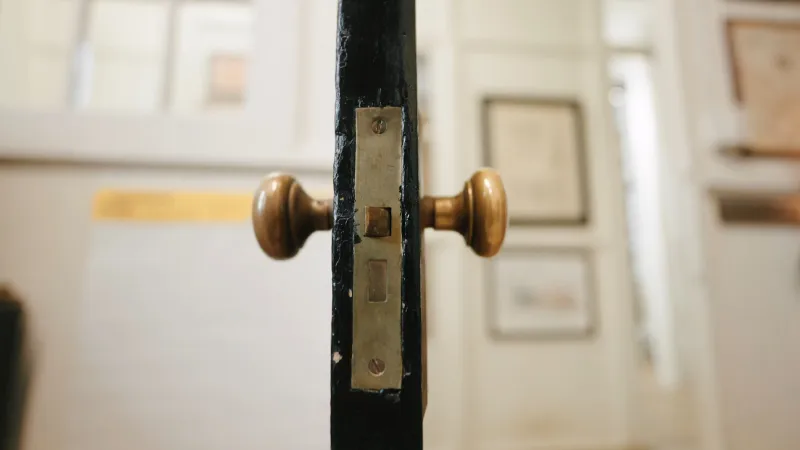
Tools Needed
There are several tools that may be needed when working with a mortise lock that won’t open. Some of these tools may be used for attempting to open the door, while others may be needed for removing the lock for repair or for repairing or replacing the latch.
Some common tools that may be needed to open a stuck or broken latch in a mortise lock include:
- Penetrating oil like WD-40: This can be used to loosen a stuck latch and make it easier to turn the lock trim.
- Flat tool like a screwdriver: This can be used to push the latch back while turning the lock trim, in an attempt to open the door.
- Pry bar: This can be used to spread the door from the frame if the hinges are not visible, as a last resort.
Other tools that may be needed for removing the lock for repair or for repairing or replacing the latch include:
- Screwdriver or drill: These may be needed to remove screws or mounting hardware that hold the lock in place.
- Protective gear like gloves and eye protection: These may be needed to protect yourself from any debris or sharp edges while working on the lock.
It is important to use the correct tools for the job to avoid damaging the lock or the door. Using the wrong size.
Before You Proceed Examine Somethings
There are a few things to consider before proceeding with any efforts to open a mortise lock that won’t open. These include:
The Type of Lock
Different types of locks may have different mechanisms and components, and they may require different approaches for opening or repairing them. It is important to know what type of lock you are dealing with before proceeding, as this can help you to determine the most appropriate course of action.
Your Level of Expertise
If you are not familiar with how locks work or how to repair them, it may be best to seek professional help. Attempting to open or repair a lock without the proper knowledge or skills can potentially cause damage to the lock or the door, and it may also compromise the security of the lock.
The Extent of the Damage
If the latch or the lock body is severely damaged, it may be necessary to replace the entire lock. In this case, it is best to seek professional help to ensure that the lock is installed properly and that it functions correctly.
The Tools and Materials Needed
Different lock repair or replacement tasks may require different tools and materials. It is important to know what tools and materials you will need before proceeding, and to ensure that you have them on hand before starting the job.
In summary, it is important to consider the type of lock, your level of expertise, the extent of the damage, and the tools and materials needed before proceeding with any efforts to open or repair a mortise lock that won’t open. This can help to ensure that the job is done safely and correctly, and it can also help to avoid any potential damage to the lock or the door.
Attempting to Open the Door
These are three options you can try to open a door with a stuck or broken latch in a mortise lock. If none of these methods work, it may be necessary to remove the lock from the door for repair.
Using a Penetrating Oil Like Wd-40 on the Latch
If the latch is stuck and preventing the door from opening, one option you can try is using a penetrating oil like WD-40 on the latch. Penetrating oils are designed to loosen stuck or rusted parts by penetrating and lubricating the surface.
To use a penetrating oil on a stuck latch, first ensure that the door is closed and the lock trim is in the locked position. Then, apply a small amount of penetrating oil to the latch mechanism, taking care to get it into any crevices or grooves.
Let the oil sit for a few minutes to allow it to penetrate and lubricate the parts. Then, try turning the lock trim to see if the latch will retract and the door will open.
Using a Flat Tool to Push the Latch Back
If the latch is stuck and the penetrating oil does not work, you can try using a flat tool like a screwdriver to push the latch back while turning the knob. To do this, insert the screwdriver into the gap between the door and the door frame near the latch mechanism.
Then, use the screwdriver to push the latch back while turning the knob. This may take some force and patience, but it may be possible to get the latch to retract and the door to open.
Using a Pry Bar to Spread the Door From the Frame
If the hinges are not visible and you are unable to access them to remove the door from the frame, you may be able to use a pry bar to spread the door from the frame and open it. To do this, insert the pry bar between the door and the frame and apply pressure to spread the door away from the frame.
You may need to remove some door trim or the door stop to access the gap between the door and the frame. This method should be used as a last resort, as it can potentially damage the door or the frame if not done carefully.
Removing the Lock for Repair
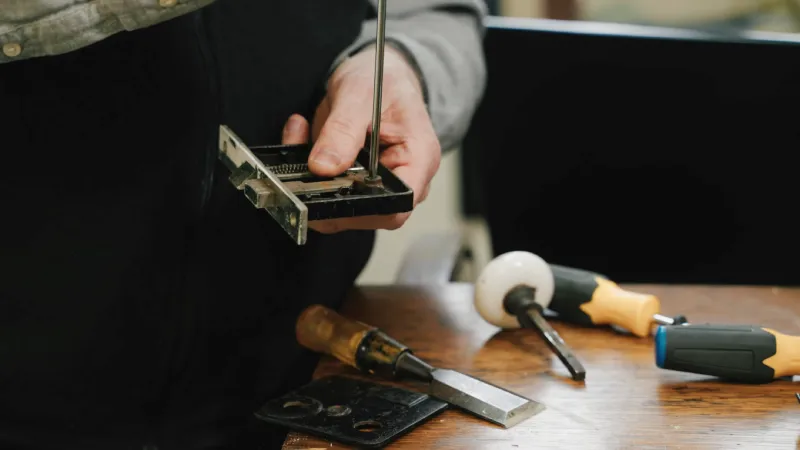
Recommended Tools and Precautions to Take
When removing a mortise lock from a door, it is important to use the correct tools and take precautions to avoid damaging the lock or the door. Here are some recommendations:
- Use the appropriate size and type of screwdriver or drill bit for the screws or mounting hardware.
- If the screws are stripped or difficult to remove, use a penetrating oil like WD-40 to loosen them before attempting to remove them.
- Take care not to apply too much force or torque to the screws or mounting hardware, as this can strip the threads or damage the lock or the door.
- Wear protective gear, such as gloves and eye protection, to protect yourself from any debris or sharp edges.
Steps for Removing the Lock From the Door
If the latch is broken or stuck and you are unable to open the door using other methods, you may need to remove the lock from the door for repair.
Here are the general steps for removing a mortise lock from a door:
- Close and lock the door.
- Identify the screws or mounting hardware that hold the lock in place. These may be visible on the exterior or interior side of the door, or they may be hidden behind decorative trim or the lock trim itself.
- Gather the necessary tools, such as a screwdriver or drill, to remove the screws or mounting hardware.
- Remove any decorative trim or cover plates that may be hiding the screws or mounting hardware.
- Carefully remove the screws or mounting hardware and set them aside.
- Gently pull the lock body out of the mortise in the door. Be careful not to damage the lock or the door as you remove it.
Potential consequences of attempting to remove the lock without proper knowledge or tools: If you attempt to remove a mortise lock from a door without proper knowledge or tools, you may cause damage to the lock or the door.
For example, you may strip the screws or mounting hardware, break the lock body, or damage the door or the door frame. It is recommended to hire a professional locksmith for lock repair or replacement to ensure that the job is done correctly and to avoid any potential damage.
Options for Repairing or Replacing the Latch
If the latch on your mortise lock is broken or damaged, you may need to repair or replace it. Here are some options for doing so:
Repairing the Latch
If the latch is not severely damaged, it may be possible to repair it. This may involve cleaning and lubricating the latch mechanism, tightening any loose screws or components, or replacing small parts like springs or pins.
Depending on the complexity of the repair, you may be able to do it yourself or you may need to hire a professional locksmith.
Replacing the Latch
If the latch is severely damaged or beyond repair, you may need to replace it. This will typically involve purchasing a new latch and installing it in place of the old one. You can purchase a new latch from a hardware store or online and install it yourself, or you can hire a professional locksmith to do it for you.
Tips for Maintaining the Lock to Prevent Future Issues
To prevent future issues with your mortise lock, it is important to maintain it regularly. Here are some tips for maintaining your lock:
Keep the Lock Clean and Lubricated
Over time, dust and debris can accumulate in the lock mechanism, causing it to become stuck or difficult to turn. To prevent this, clean and lubricate the lock regularly with a penetrating oil like WD-40.
Tighten Any Loose Screws or Components
If any screws or components in the lock become loose, they can cause the lock to malfunction. Check the lock periodically and tighten any loose screws or components to ensure that the lock is functioning properly.
Replace Worn or Damaged Parts
If any parts of the lock are worn or damaged, they may cause the lock to malfunction or fail completely. Replace any worn or damaged parts as soon as possible to prevent future issues with the lock.
In summary, if the latch on your mortise lock is broken or damaged, you have the option of repairing or replacing it. To prevent future issues with your lock, it is important to maintain it regularly by keeping it clean and lubricated, tightening any loose screws or components, and replacing any worn or damaged parts.
What Things You Should Check While Dealing With Moist Lock?
Here are some additional tips for dealing with a mortise lock that won’t open that were not discussed in the previous sections:
Check the Lock Trim for Damage
If the lock trim is damaged, it may be difficult or impossible to turn it to open the door. Check the lock trim for any cracks, chips, or other damage that may be preventing it from turning smoothly. If the lock trim is damaged, it may need to be replaced.
Check the Lock Body for Damage
If the lock body is damaged, it may prevent the latch from retracting properly. Check the lock body for any cracks, chips, or other damage that may be causing the latch to become stuck or misaligned. If the lock body is damaged, it may need to be replaced.
Check for Any Foreign Objects in the Lock
Sometimes, foreign objects like keys or paper clips can become stuck in the lock mechanism, preventing the latch from retracting. If you suspect that a foreign object may be causing the problem, try to gently remove it from the lock mechanism.
Check for Any Debris or Rust in the Lock
Debris or rust can accumulate in the lock mechanism over time, causing the latch to become stuck or the lock components to become misaligned. Clean and lubricate the lock regularly to prevent debris or rust from accumulating and causing problems.
Use Caution When Trying to Force the Door Open
If you are unable to open the door using other methods, you may be tempted to use force to try to open it. However, using excessive force can potentially damage the lock or the door, and it is not recommended. If you are unable to open the door using other methods, it is best to seek professional help.
In summary, these are some additional tips for dealing with a mortise lock that won’t open. If you are unable to resolve the issue on your own, it is important to seek professional help to avoid damaging the lock or the door.
Final Words
If a mortise lock won’t open, there are a few steps you can take to try to resolve the issue. These include using a penetrating oil like WD-40 on the latch, using a flat tool like a screwdriver to push the latch back while turning the knob, and using a pry bar to spread the door from the frame if the hinges are not visible.
If none of these methods work, you may need to remove the lock from the door for repair. This may involve removing screws or mounting hardware, and it is recommended to hire a professional locksmith for this task to ensure that it is done correctly and to avoid damaging the lock or the door.
It is important to seek professional help if you are unable to resolve the issue with your mortise lock or if you are unsure of how to proceed. A professional locksmith has the knowledge and experience to accurately diagnose the problem and fix it without causing any further damage to the lock or the door.
Seeking professional help can save you time and frustration, and it can also help to prevent any potential security issues that may arise from a faulty lock.


